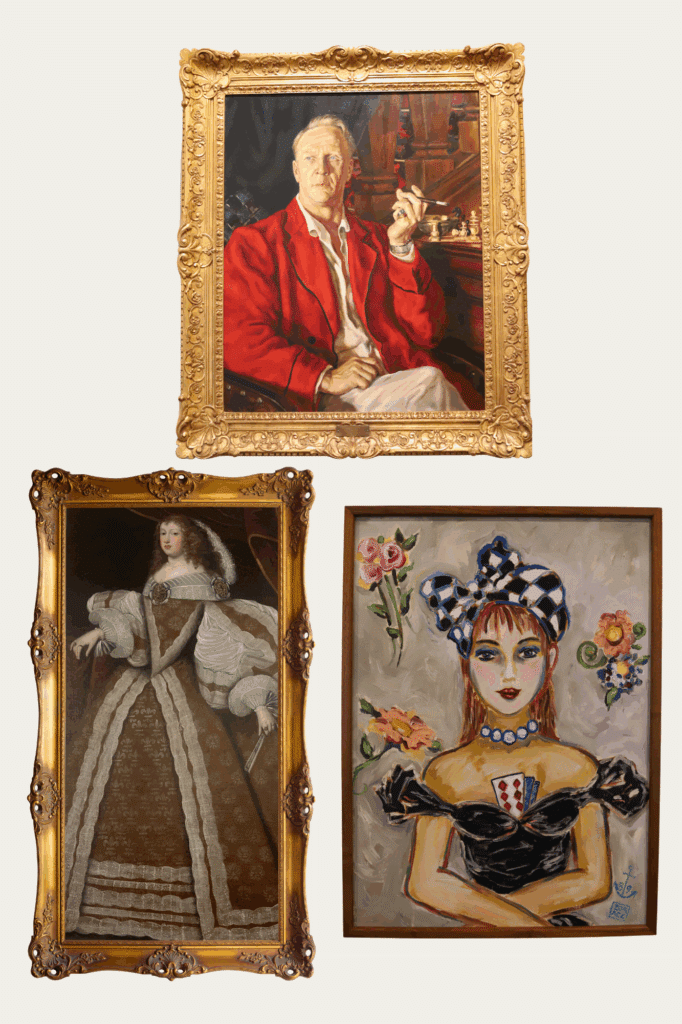Apparently, they’re all troublemakers.
Meg Shaver, manager of Penrose House Conference Center, holds a deep appreciation for all the art displayed in the historic estate. Among the vast collection, however, her most cherished pieces are those she deems to be troublemakers: artwork that provokes a reaction, sparks a conversation, and challenges expectations.
Her most beloved artwork is “Young Girl with Playing Cards” (1989) by Zoa Ace. The painting features a woman in a casino with playing cards tucked into her cleavage. Sarah Woods, Associate Vice President of Collections at El Pomar, explains that the piece was acquired by the Foundation to reflect “the spirit of Colorado’s early mining culture.” However, as Shaver explains, it caused problems when it was hung in the Cripple Creek Room, which has since been renovated into the Julie Penrose Room. Shaver recalls:
“Often when I would book people in the Cripple Creek Room, they would take off that piece and turn it around.”
Shaver found the girl’s knack for causing a stir endearing, and the piece now hangs in her personal office.
The next piece Shaver points out depicts a Russian opera singer: a man in a red jacket with a gold ring on his finger, cigarette in hand, and a smug expression on his face. It is a portrait of Feodor Chaliapin by his son Boris Chaliapin (1929), gifted to the Penroses in 1931 to honor Julie Penrose’s love for opera.
Shaver is drawn to the artwork’s polarizing nature. “People either really love it or hate it,” she explains, “He just has that look of, ‘I’m all that.’”
The final piece on Shaver’s list is “Portrait of a Lady of Quality,” a depiction of Holy Roman Empress Maria Theresa of Austria. Grand and imposing, it commands attention with its ornate frame and regal presence. At first glance, guests often admire it, but when Shaver asks what they like about it, their expressions often shift. That’s when people notice her disjointed torso and uneven arms. Woods explains that this piece is a copy of a famous portrait, likely created by a practicing painter. But to Shaver, these imperfections aren’t flaws. Instead, they’re what make the painting compelling, drawing viewers in to look twice.
To some, it may be hard to see the connection of these artworks to the Penroses, but to Shaver, each piece embodies the couple’s rebellious spirit. Together, the Penroses built an extraordinary legacy by taking on the trouble of doing more than what was ordinary. They didn’t follow the rules; they rewrote them.
Spencer Penrose was the youngest of several highly accomplished brothers who were leaders in the fields of medicine, politics, and geology. He grew up with a strict definition of success that he quickly realized wouldn’t work for him. He headed west, forging his pioneering legacy by making bold, unconventional decisions that bucked societal norms.
Julie Penrose was no less daring, bravely facing life after losing her first husband and son within a month of each other. Instead of returning home to Detroit to be closer to her family, she chose to stay in Colorado Springs and made her mark as her family did in Michigan as a forward-thinking philanthropist with a passion for community building and culture. She had vision and determination and went after what she wanted.
The couple crafted a captivating life story and laid the foundation for the Colorado Springs we know today. Now, Shaver reminds us that we are charged with continuing their legacy.
“You and I weren’t there [then], but because we are here now, we are part of that story.”
Civil rights leader John Lewis once said, “Get into good trouble.” The art at Penrose House is a reminder that good trouble is out there: the kind that inspires a copper magnate to build a highway up Pikes Peak, or a grieving widow to carry on a once shared philanthropic mission, or a team at El Pomar to ask yet again, “How can we better show up for Colorado?”
That’s the kind of trouble worth getting into.



